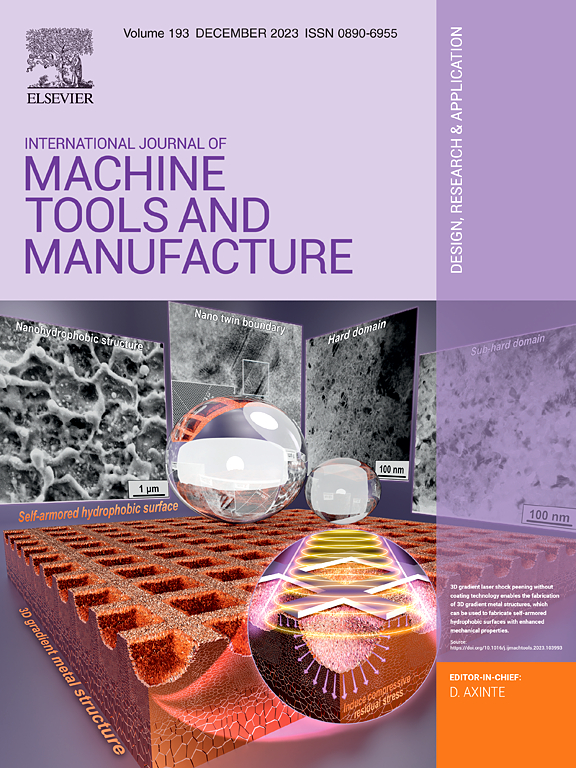Inducing electrochemical discharges on insulating surfaces for damage-free electrochemical jet machining of glass
IF 18.8
1区 工程技术
Q1 ENGINEERING, MANUFACTURING
International Journal of Machine Tools & Manufacture
Pub Date : 2025-05-20
DOI:10.1016/j.ijmachtools.2025.104293
引用次数: 0
Abstract
A key limitation of electrochemical jet machining (EJM) is its inability to process insulating materials. While electrochemical discharge machining (ECDM) can handle such materials, its contact-based nature often causes thermal damage. Additionally, the challenge of initiating electrochemical discharges on the insulating workpiece, rather than on the tool electrode, remains unresolved. This study presents a new mechanism for directly inducing electrochemical discharges on insulating surfaces through the controlled interplay of electro- and hydrodynamic fields. For the first time, we demonstrate damage-free machining of insulating materials using an electrolyte jet, in a new process termed jet-electrochemical discharge machining (Jet-ECDM). This is achieved by generating electrochemical discharges at the jet-impingement zone on the insulating workpiece surface, with the gas evolved at the nozzle electrode acting as a dielectric. The spatiotemporal dynamics of discharges, including location, frequency, and intensity, are analyzed and shown to critically influence machining results. High-speed imaging visualizes the gas bubble behaviors, while simulation reveals how discharges are focused onto a localized machining area through concentrated electric fields and gas distribution. Key process parameters, including voltage, working gap, and electrolyte flow rate, are identified for effective process control. Thermocouple measurements show a discharge-induced average temperature rise of ∼160 °C at the machining site. Unlike conventional ECDM, Jet-ECDM's non-contact approach avoids thermal damage, enabling stress-free, purely chemical material removal. This is validated by machining microfeatures in quartz glass, achieving superior surface finishes (∼Ra 50 nm) and a damage-free subsurface. This research extends the material applicability of EJM to insulating materials and introduces a novel method for stress-free machining of glass and ceramics using electrochemical discharges.

在绝缘表面诱导电化学放电,用于玻璃的无损伤电化学喷射加工
电化学喷射加工(EJM)的一个关键限制是它不能加工绝缘材料。虽然电化学放电加工(ECDM)可以处理这类材料,但其基于接触的性质往往会导致热损伤。此外,在绝缘工件上启动电化学放电的挑战,而不是在工具电极上,仍然没有解决。本研究提出了一种通过控制电场和水动力场的相互作用在绝缘表面上直接诱导电化学放电的新机制。我们首次展示了使用电解液射流对绝缘材料进行无损伤加工,这是一种称为射流-电化学放电加工(jet- ecdm)的新工艺。这是通过在绝缘工件表面的射流撞击区产生电化学放电来实现的,在喷嘴电极处产生的气体充当电介质。分析了放电的时空动态,包括位置、频率和强度,并表明放电对加工结果有重要影响。高速成像可视化气泡的行为,而模拟揭示了放电如何通过集中的电场和气体分布集中在局部加工区域。确定关键工艺参数,包括电压、工作间隙和电解质流速,以进行有效的过程控制。热电偶测量显示,在加工现场,放电引起的平均温升为~ 160°C。与传统ECDM不同,Jet-ECDM的非接触式方法避免了热损伤,实现了无应力、纯化学材料的去除。通过加工石英玻璃的微特征,实现了卓越的表面光洁度(~ Ra 50 nm)和无损伤的亚表面,验证了这一点。本研究将EJM的材料适用性扩展到绝缘材料,并介绍了一种利用电化学放电无应力加工玻璃和陶瓷的新方法。
本文章由计算机程序翻译,如有差异,请以英文原文为准。
求助全文
约1分钟内获得全文
求助全文
来源期刊
CiteScore
25.70
自引率
10.00%
发文量
66
审稿时长
18 days
期刊介绍:
The International Journal of Machine Tools and Manufacture is dedicated to advancing scientific comprehension of the fundamental mechanics involved in processes and machines utilized in the manufacturing of engineering components. While the primary focus is on metals, the journal also explores applications in composites, ceramics, and other structural or functional materials. The coverage includes a diverse range of topics:
- Essential mechanics of processes involving material removal, accretion, and deformation, encompassing solid, semi-solid, or particulate forms.
- Significant scientific advancements in existing or new processes and machines.
- In-depth characterization of workpiece materials (structure/surfaces) through advanced techniques (e.g., SEM, EDS, TEM, EBSD, AES, Raman spectroscopy) to unveil new phenomenological aspects governing manufacturing processes.
- Tool design, utilization, and comprehensive studies of failure mechanisms.
- Innovative concepts of machine tools, fixtures, and tool holders supported by modeling and demonstrations relevant to manufacturing processes within the journal's scope.
- Novel scientific contributions exploring interactions between the machine tool, control system, software design, and processes.
- Studies elucidating specific mechanisms governing niche processes (e.g., ultra-high precision, nano/atomic level manufacturing with either mechanical or non-mechanical "tools").
- Innovative approaches, underpinned by thorough scientific analysis, addressing emerging or breakthrough processes (e.g., bio-inspired manufacturing) and/or applications (e.g., ultra-high precision optics).

 求助内容:
求助内容: 应助结果提醒方式:
应助结果提醒方式:


